#ukrainian folktales
Photo
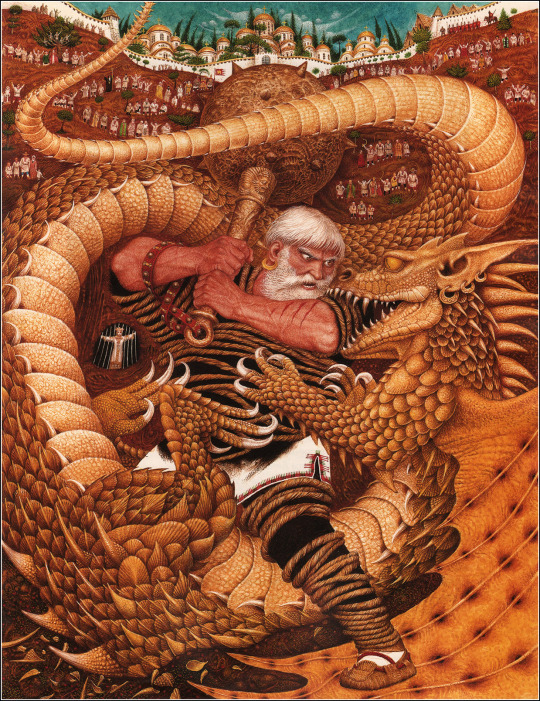
The Ukrainian folktale Kyrylo the Tanner, illustrated by Vladyslav Yerko.
#ukrainian art#ukrainian artists#ukrainian folktales#ukrainian fairytales#fantasy art#dragons#dragon art#slavic folklore#ukrainian folklore#illustration#childrens illustration#fantasy illustration#art#my post#vladyslav yerko
47 notes
·
View notes
Text






ukrainian fairytales illustrated by kateryna shtanko
404 notes
·
View notes
Text
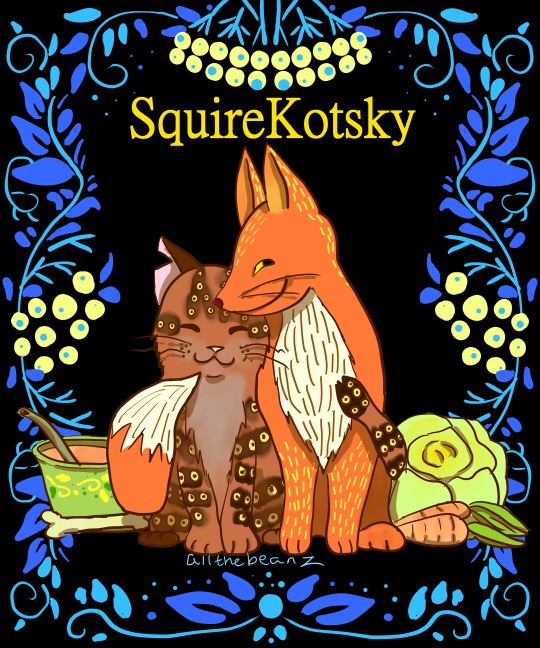
Squire Kotsky
A common Ukrainian story about an old cat who becomes a fox's husband after being thrown out by his owner. The fox tells the other animals that her husband will 'tear them to shreds', so when the hare, boar, wolf, and bear visit for dinner, they are all very nervous of the cat and hide. The cat unknowingly frightens all of them off (just by doing cat things) and the fox and the cat eat all the dinner food.
Inspired by the Ukrainian folk painter Maria Prymachenko and the Petrykivka style.
Shop
38 notes
·
View notes
Text
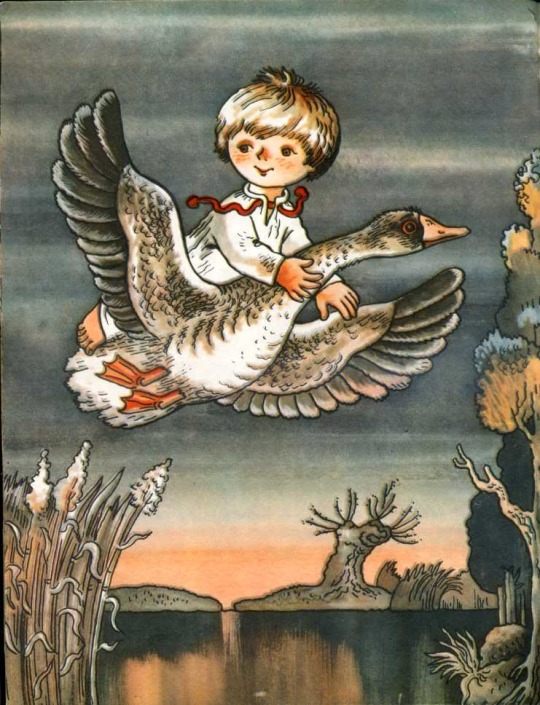
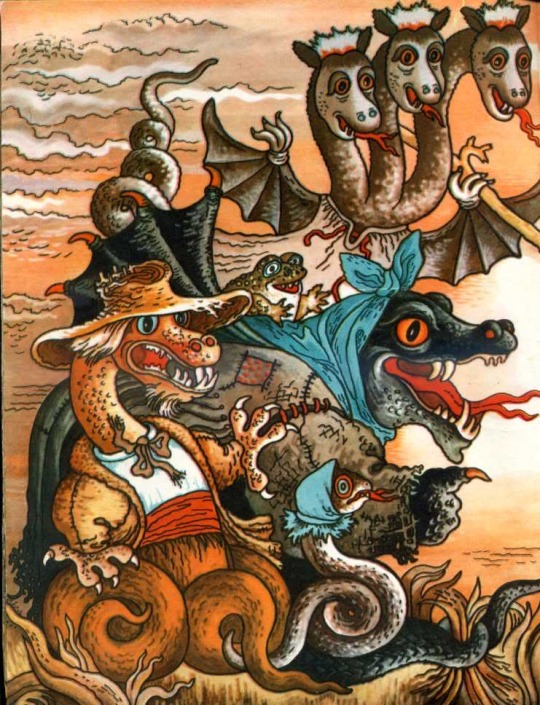
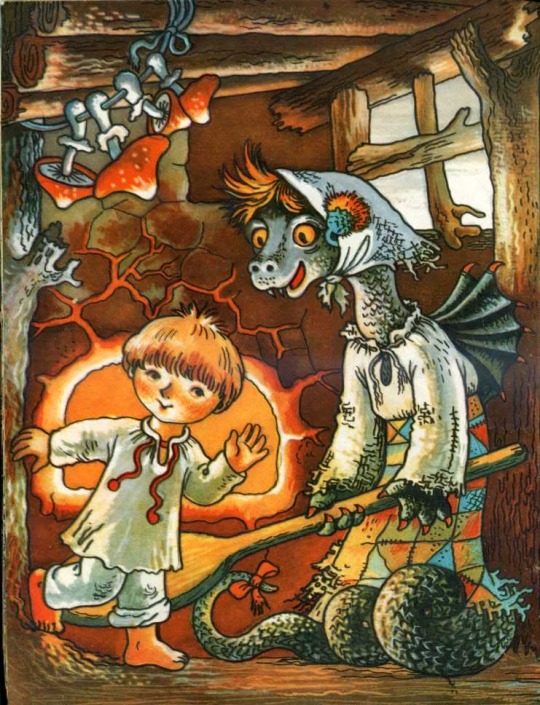

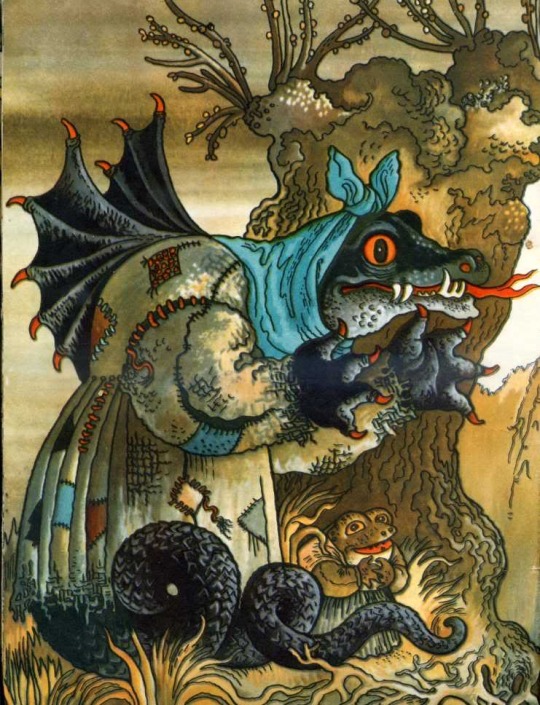

Телесик / Telesyk, 1987
Художниця: Валентина Мельниченко
Artist: Valentyna Melnychenko
363 notes
·
View notes
Photo


The Poterchata [Ukrainian mythology]
Small, supernatural flames or lights that float over swamps and marshes are a commonly reoccurring theme in myths and beliefs from around the world. Today, such sightings are usually attributed to swamp gases but in the past they were often thought to be ghosts, spirits or undead souls.
The Poterchata are one version of that story, they originate from Ukrainian legends. These ghosts are the souls of unbaptized children (usually under 8), which also includes babies who died during childbirth. Unable to pass on to the afterlife, they were doomed to wander the Earth.
These are dangerous spirits and would manifest as floating lights to lead curious or lost travellers into the water, where they would drown. They could also be heard laughing and crying in deep forests. There are also accounts of Poterchata tickling a victim to death, or just trying to scare travellers in the dark. But they were not entirely evil, as these spirits could be saved.
They fly around at night, and are considered related to the Ukrainian Mavka, spirits of young girls who were associated with water. They inhabit lakes and rivers.
In one version, the Poterchata take the form of birds, and they remain like that for 7 years after the death of their human body. In Podolsk (Ukraine) and Belarus, they turn into mermaids (note the recurring association with water or water spirits). In this form, they still resembled children, but had a blueish skin. In literature and fiction, Poterchata were sometimes depicted as corporeal, humanoid creatures with monstrous characteristics like fangs and claws.
It is considered polite and customary to give a piece of cloth to these spirits if you happened to encounter one. This is related to an Ukrainian custom where the godparents of a newly born child gift a towel to the parents, to wrap and hold the baby. One should also leave a small crucifix for the spirit.
In some versions, the spirits are nameless because a child only ‘officially’ receives their name when they are baptized. Hence, they were buried in a nameless grave, and it is said that you could hear wailing or crying if you held your ear next to their gravestone. I am uncertain what time period or region this statement comes from.
Hanna Barvinok, (the pseudonym of) a 19th century Ukrainian writer and folklorist, wrote in her story about mermaids that unbaptized children were often buried underneath the house of their parents. Sometimes you could hear their voice, complaining that their mother buried them. It was also common to bury the child close to the fireplace, as the fireplace of the house was a culturally important spot where the spirits of the family’s ancestors were thought to dwell. The reasoning here is by burying the infant here, it would be left in the care of its ancestors, who would protect it against evil spirits. In some places in Russia, unbaptized children and infants would be buried underneath a tree instead.
Sources:
Романова, O. M., 2018, ДИТЯЧИЙ ОБРАЗ ЛІСОВОЇ ДЕМОНОЛОГІЇ В ТРАДИЦІЙНИХ ВІРУВАННЯХ. ПОТЕРЧАТА, in: ІСТОРИЧНІ НАУКИ, 23, p76-81 (The child’s image of forest demonology in traditional reliabilities: Poterchata, in: Historical Sciences)
Fody, G. D., 1963, A survey of the mythology of Kievan Rus’ and its survivals in the folklore of the eastern Slavs, thesis submitted to the faculty of graduate studies in partial fulfillment of the requirements for the degree of master of arts, University of Alberta.
Riazantseva, T., 2020, Slavic folktale characters in Serhiy Oksenyk’s fantasy trilogy: walking, flying, floating, САВРЕМЕНА СРПСКА ФОЛКЛОРИСТИКА, C.381-388.
(image source 1: Daria Zhuk on Artstation)
(image source 2: Olha Nazarets on Artstation)
#Ukrainian mythology#Slavic mythology#ghosts#undead#mythical creatures#art#mythology#myths#folklore#folktales
192 notes
·
View notes
Text
"That Quidditch Cup'll have our name on it this year," said Wood happily as they trudged back up to the castle. "I wouldn't be surprised if you turn out better than Charlie Weasley, and he could have played for England if he hadn't gone off chasing dragons." — Harry Potter and The Philosopher's Stone
Given the Weasley's financial situation, Charlie Weasley playing professional quidditch must have been that once-in-a-lifetime golden opportunity. An ultimatum against the chronically suffering Weasley finances. Quidditch is like the soccer of the wizarding world—the cultural impact and stardom it brings are phenomenal! Not to forget the hefty income!
If anyone cared, the fact that Charlie dared to choose dragons over professional quidditch must come off as sheer stupidity and even disrespectful.
Many students at Hogwarts must have been really baffled and maybe disappointed. Somewhere along, I bet it may have become a shared dream of the students, some professors, and the Weasleys to see Charlie Weasley play professional quidditch.
His choosing dragon handling over quidditch would have been the gossip of the year! Some won't care, some will think him a moron, some will be a little heartbroken, and a few will probably worship him! Throughout the remaining Hogwarts year, topics like money matters, passion, success, etc. would be casually thrown around. By the end of the year, people might become more accepting and maybe understand.
It goes without saying that Charlie Weasley would be struck in a battle of his own. A million thoughts per minute would race through his mind. A war of dreams and hopes. He knows his way but has never felt so lost. He will inform an omniscient professor McGonagall of his choice, words that will politely decline the two scouts airing through his head.
In the summer after his tiring yet satisfying, first internship in Wales, he will meet a frustrated mother mourning about the perils of dragon-keeping, who then hogs his dragon,-keeping guides for the better part of her free time. His father will tell him muggle fairytales and folktales about dragons. Bill, his forever partner in crime, would secretly sneak him to Gringotts to see the half-blind, majestic Ukrainian Ironbelly. Percy will educate him about the mysterious connection between dinosaurs and dragons that makes those beasts entirely more endearing to him. The twins will worship him for being too cool for quidditch and persuade him to rather become a dragon dealer. Ron will ask him all kinds of questions about dragons and quidditch while brutally defeating him at chess. He will braid Ginny's hair while listening to her monologue rant about dragons vs. quidditch. Before going to bed, she will make him promise to get her a baby dragon. After a few minutes of pleading, he will give in– but only for a day in Romania.
As rare as it comes, we find people who actually dare to dream and, rarer still, who achieve their dreams.
#harry potter#charlie weasley#quidditch#dragons#the weasleys#arthur weasley#molly weasley#bill weasley#percy weasley#fred weasley#george weasley#ron weasley#ginny weasley
229 notes
·
View notes
Text
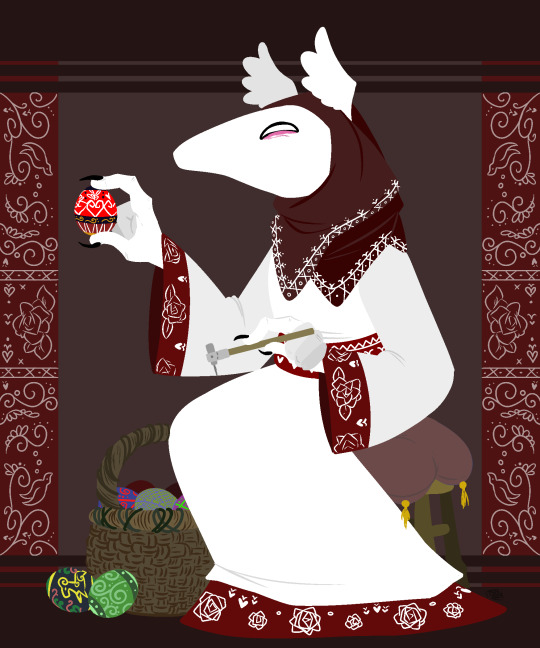
Happy Easter; Have you heard of Pysanky Eggs? They're a Ukrainian Custom of decorating eggs with beautiful patterns with wax and dye, depicting traditional patterns, designs and symbols to ward off evil.
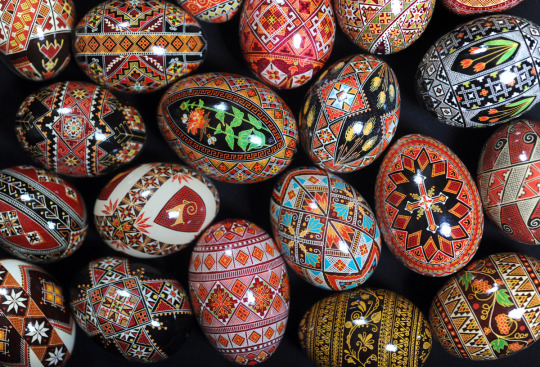
Each color and pattern means something unique; ranging from religious iconography to traditional folktale patterns, even to the colors having their own symbols.
I'm honestly a big fan
#TSB Draws#Pysanky Egg#Pysanky#Grandmother Beetroot#Beetroot#Babushka Beetroot#Granny Beets#Slavic tradition#Ukrainian eggs
264 notes
·
View notes
Note
Hi there. I have seen your post/text about Slavic dragons shapwshifters. You nailed it, comming from a Slav. Can you tell me which source you used? What are other Slavic folklore/mythology sources you use.😀
That is very encouraging to hear! I always get nervous working from translations :P
The examples given in the post about dragon shape shifters all come from Norbert Guterman's 1946 translation of Aleksandr Afanas’ev's 1866 folktale collection: Russian Fairy Tales.
It's one of my favourite collections! I only wish it would have specified the region of origin for the different tales, so they would be easier to place outside of the 19th century context they were written down in.
I've also drawn from these in the past:
Myths and Folk-tales of the Russians, Western Slavs, and Magyars; Jeremiah Curtin, 1890.
The Russian Garland of Fairy Tales: Being Russian Folk Legends Translated from a Collection of Chapbooks Made in Moscow; Robert Steele, 1916.
The Russian Story Book; Containing tales from the song-cycles of Kiev and Novgorod and other early sources; Richard Wilson, 1916.
And these I have read a little of, but are still in my to-read folder:
Cossack Fairy Tales and Folk Tales; R. Nisbet Bain, 1916.
Ukrainian Folk Stories; Marko Vovchok, 1966 (transl. N. Pedan-Popil, 1963).
Ukrainian Folk Tales; Marie Halun Bloch (translated from the collection of I. Rudchenko and M. Lukiyanenko), 1964.
If you have any recommendations yourself, please feel free to add them!
27 notes
·
View notes
Note
Добридень! Як ся маєте?
I've been looking everywhere for a way to read old slavic mythology, and about the old gods. What would be the best place to start?
Дякую! :-)
(Sorry for the mixed languages btw, I hope you can read Ukrainian)
Hello!
I have great news! I have a whole list of resources prepared for this very occasion!
I also have some slightly worse news which is that there is very little known about Slavic mythology and most of what we know Slavists deduced through a mix of analysing of the later folklore, linguistics and comparative mythology. As a result the known Slavic pagan mythology is more a collection of theories than a collection of concrete myths and slightly harder to read through.
You could start by reading some longer pieces on my list of sources that offer broader view of Slavic mythology (Sources of Slavic Pre-Christian Religion, Supernatural beings from Slovenian myth and folktales, Russian folk belief, Slavonic pagan sanctuaries perhaps The mythology of all races volume III if you merely want a quick general introduction), and then once you find specific things that interest you, dig your way through the articles on the subject, either on the list, on Studia Mythologica Slavica or on Researchgate and Academia.edu (be more careful with the latter, occasionally the articles published there are pardon me bullshit). I also frequently leave small lists of sources in my answered asks about Slavic paganism so you could look through that to get an idea where to go next.
And yeah I have a decent understanding of Ukrainian - certainly best of all Slavic languages except for my native Polish 😁
Best of luck
Zarya
27 notes
·
View notes
Text
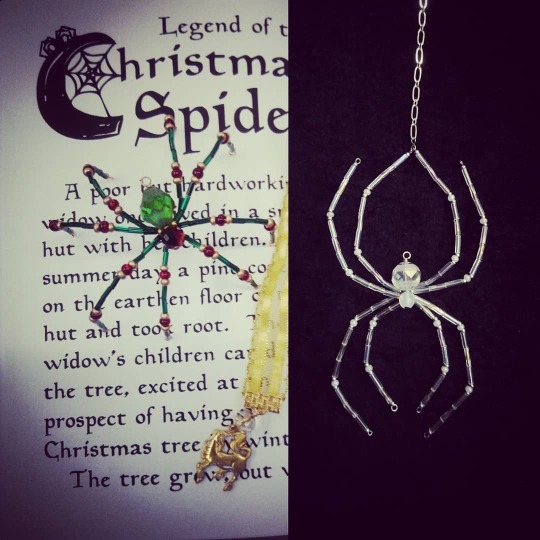
Legend of the Christmas Spider
A poor but hardworking widow once lived in a small hut with her children. One summer day, a pine cone fell on the earthen floor of the hut and took root. The widow's children cared for the tree, excited at the prospect of having a Christmas tree by winter. The tree grew, but when Christmas Eve arrived, they could not afford to decorate it. The children sadly went to bed and fell asleep. Early the next morning, they woke up and saw the tree covered with cobwebs. When they opened the windows, the first rays of sunlight touched the webs and turned them into gold and silver. The widow and her children were overjoyed. From then on, they never lived in poverty again.
~Ukrainian folktale
(Beaded spiders made by, and story abridged by me @mirebast)
12 notes
·
View notes
Text

Baba Yaga's Book of Witchcraft: Slavic Magic from the Witch of the Woods
Move Swiftly On Your Own Two Feet, for Baba Yaga You Must Meet
Discover ancient and modern Slavic magical practices through stories told by the legendary Baba Yaga herself. Learn about the magic of the sun, moon, and stars, as well as the magic of weather, animals, seasons, stones, food, beeswax, and more. Each chapter includes a piece of the fairy tale of Vasylyna, comments from Baba Yaga, and hands-on tips and techniques from author Madame Pamita.
Explore magical activities alongside authentic folktales about the birth of the sun and the land of the blessed ones. Step-by-step instructions show you how to stitch Ukrainian folk embroidery motifs into protective charms, weave wreaths from herbs, make enchanted poppets, and work with the spirits of the forest, the hearth, and the sauna. With a bounty of tips and information, this book teaches you to embrace the beauty of these traditional practices and reclaim your personal magic.
https://amzn.to/3OIOgRV
7 notes
·
View notes
Text
Given people tend to have a short-lived memory on the Internet, let's recall together one of the ridiculous moments of Putin's Russia's propaganda against Europe. It is something that happened very recently, and for once it is not an ideological or social conflict or propaganda. No, it is a meteorological one - a story that might seem laughable and absurd, just a good joke on its own, but a story that shows us how deeply buried in lies and falseness and a complete detachment from reality the Russian propaganda is. This highlights the sad truth of how Russian media became a mass-fake-news machine and is ready to twist and turn every little fact of life to serve their own "Russia is the greatest, the rest of the world is Hell" view.
This happened in the winter of 2022-2023. If you are not in Europe maybe you didn't hear about this, but it was all over here. If you do not recall, this winter was actually colder than the one of previous years - which notably caused a certain problem because there was an economic crisis going on thanks to the Ukrainian war. There is this big price inflation all across Europe, coupled with the fact we don't get the Russian oil and gaz anymore - and this slightly colder weather mixed with the more costly every day life and the lack of heating fuels were all used by Russian propagandist to announce that Europe was going to face its harshest and coldest winter yet, and that thanks to the Ukrainian war, they would all freeze to death. If you listened to the words of Russian information channels, it was as if ASOIAF's "Winter is coming" was happening in real life.
Putin notably used a sentence referring a very popular Russian fairytale (though it is actually a folktale also heavily present in Europe, especially in France where it is part of the Roman de Renart) - "The wolf's tail will freeze". For Putin, Europe was the wicked and greedy wolf, and this harsh icey winter would weaken Europe the same way the wolf who was tricked into fishing with his tail got trapped in the lake of ice...
Let's begin with a "little lie", well a big one, but still lesser compared to the others that follow in this post. Mid-March, Olga Skabeyeva (one of the famous propagandist news anchors of Russia) claimed that due to the rise of prices, a third of the inhabitants of France was forced to give up on hygiene and beauty products. According to her, a third of French people didn't use shampoo or deodorants anymore, a third of French people didn't clean their teeth anymore - they even had to abandon toilet paper due to it costing too much! And of course, Skabeyeva concluded that this was all because France gave too much money to Ukraine, leaving its own people "poor and dirty"... Note that this actually plays on a widespread stereotype French have among foreigners: the reputation of French being dirty for only taking a bath once a week or so. I don't know where this stereotype of the French that doesn't take care of their personal hygiene comes from, but it exists.
If you are from Britain, you probably heard about Olga Skabeyeva's famous comments about the poor state the harsh winter and economic crisis of England had left people into. Mid-January she affirmed on Russian television that the common British folks were forced to eat dog food and cat food because human food was too costly, and that now English households cooked on their radiators, since they could only afford one heater for the whole house. This was backed up in early March by her claims that British restaurants, due to a lack of animal meat, were forced to serve squirrels to their clients, and that they would go on to trap other animals found in parks. Many British people argued back that yes, there was a big and harsh crisis, but no it wasn't as bad as the propagandist claimed and no, nobody ate squirrels in restaurants. [I unfortunately cannot find back the source but I recall seeing around the time this made the news, that the propagandist actually took one true info - something about indeed people killing squirrels somewhere in England for health and ecological reasons, or maybe some public figure joking about possibly eating squirrels - and then twisted it into "all British restaurants serve squirrels now". That's typical of propagandists - take one grain of truth, make it a whole beach of lies.]
And then we reach Germany. This time I have sources to back up, exact sources I will bring to you. In fact, if you want to know more about the crazy world of Russian propaganda, I can't advise you enough to check out this very informative and eye-opening series: Arte's Fake News. Arte is a Franco-German binational channel that brought this program - originally a web-series, that also aired on television. "Fake News", of its full title, "Fake News: Russian propaganda for beginners", is a series created and hosted by Marsha Borzunova, the representative of a group of anti-Putin Russian journalists that exiled themselves. Now, from the town of Riga, she and her crew created these videos that study, debunk and explain the various aspects of Russia's propaganda.
And one of her videos covered the topic of "European winter as seen by Russia". She talked of Putin's "wolf's tail" comment, she talked of how Russian television channels claimed that Czech figureheads publically said that to survive winter they will burn "everything they get their hands on", and even burn Ukraine down... And she also brought up the "Berlin problem". During the last months of the year 2022, Russian newspaper multiplied reports that due to the lack of oil/gaz and the extreme temperatures of winter, Berliners were cutting down almost all of the trees in their public parks. Which of course, is something that never happened. But these newspapers listed an American article from Bloomberg as their sources - and when you go look at the article, you realize how heavily the propagandists twisted the original words. The Bloomberg article was about the energy crisis in Germany, indeed, and how wood-fueled heating systems were now preferred and demanded over gaz-fueled heating systems, but that was it. The article did mention public park trees being cut down as an example... as an HISTORICAL example. The article speaks of the cutting of the Tiergarten trees in WORLD WAR II!!!
To add salt to the wound, there is the existence of a television show in Russia called "Antifake", designed to debunk fake news and denounce propaganda. Not Russian one though - the point of this show is to destroy the "lies of the West" and reveal the "truth" about Europe. Which is, as you can guess, a pile of absurd and shameless lies in favor of Russia. Antifake most notably fed into the whole "Europeans are freezing to death" thing by having their reporter living in Germany, a woman called Yulia, do a live interview from her apartment in Munich - and she appeared in this interview wrapped into a big, heavy winter coat, fur-lined hood over her head, despite being inside. Because, as she explained, the furnace had been cut for the night and in the morning, and so she was waiting for noon to have the sun heat her apartment into a more bearable temperature. An interview that becomes absolutely ridiculous when you know that at the same time, in Munich (Yulia's town), it was mid-october, it was a sunny week with 18 degrees outside (I'll let you do the conversion if you are American). Nobody in their right mind was wearing a coat inside their house, and nobody wore heavy coats outside either, and there was no furnace cuts. Even more hilarious is the fact that the emission showed background videos recorded of European heavly clothed, sharing food at some charity stand in a freezing morning... Except that when you look at the signs in this supposedly "German sight", you see everything is written in cyrillic, and that's because these images were recorded in the town of Opotchka, in the Pskov region, not "near Berlin" as they wanted the audience to think. Speaking of Yulia - you might have heard of her outside of the "Antifake" show, because she made herself quite famous in Germany, even viral. She went viral because she posted a video of herself smiling and dancing with a Russian flag... In front of a group of Ukrainian refugees in Salzburg. She became known as the "Russian harasser of Ukrainians fleeing the war" in Germany.
Borzunova also mentions the cyber-war of fake news to conclude her look at Russian's fantasies about a winter of misery in Europe: on Twitter, there was a trend that spread, a hastag #AgainstSanctions. This hashtag was shared and posted by many Europeans of various countries, complaining that the sanctions taken against Russia were ruining their life. The trend was simple: post a picture of an empty plate, with a message written on a piece of paper onto the plate, directly demanding to your local politician to stop the anti-Russia sanctions.
Here's the thing however: this "trend" was reported by Russian institutions and medias. And while the posts of this hashtag do exist, when you look just a little bit deeper you realize how fake it all is. All the accounts that started this trend only have one post in total: the AntiSanctions post. All these accounts were created on the same day. AND their profile pictures are those of public figures - ranging from CNN news anchors to Bollywood actresses.
Anyway, if you want to check the video about all of this, you can go look at it on Youtube. I personally watched the French subtitled version, even though there is a German-subtitled one (thanks to Arte being Franco-German), and Borzunova speaks in English, so you can still listen to her comments and understand her explanations without reading French or German:
youtube
If the video above doesn't appear, here is the link.
#russian propaganda#russia#fake news#putin's propaganda#europe through the eyes of russians#russian propaganda for beginners#Youtube
16 notes
·
View notes
Text
SLAVIC RESOURCES
The Anthropological Masterlist is HERE.
The Slavic people, or Slavs, are a European people. They are native to central and eastern Europe, including Siberia.
BELARUS ─ “The Belarusians, or Byelorussians, are an East Slavic people. They are native to Belarus.”
─ Belarusian Information
─ Belarusian Poetry
─ Belarusian Dictionary
BULGARIA ─ “The Bulgarian people are a South Slavic people. They are native to Bulgaria.”
─ Bulgarian Clothing (in Bulgarian)
─ Bulgarian History
─ Bulgarian Language
*ILLYRIA ─ “The Illyrians were an Indo-European people that lived from 1000 B.C.E. to 500 C.E. They lived in the historical area of Illyria.”
─ Illyrians to the Greeks
─ Illyrian Language
MACEDONIA ─ “The Macedonian people are a South Slavic people. They are native to Macedonia.”
─ North Macedonia Information
─ Macedonian History
─ Macedonian Dictionary (in Macedonian)
POLAND ─ “The Polish, or Pole, people are a West Slavic people that share the Polish culture. They are native to Poland.”
─ Polish Art
─ Polish History
─ Polish Dictionary
RUSSIA ─ “The Russian people are an East Slavic people that share the Russian culture. They are native to Russia.”
─ Russian Culture (in Russian)
─ Russian Folktales
─ Ancient Russia
SERBIA ─ “The Serbian, or Serbs, people are a South Slavic people. They are native to the Balkans.”
─ Serbian History
─ Serbo-Croatian Dictionary
SLOVENIA ─ “The Slovene, or Slovenian, people are a South Slavic people that share the Slovenian culture. They are native to Slovenia.”
─ Coastal Galleries in Slovenia (in Slovene)
─ Slovene Dictionary (in Slovene)
UKRAINE ─ “The Ukrainians are an East Slavic people. They are native to Ukraine.”
─ Ukrainian Information
─ Ukrainian History
─ Ukrainian Language
WENDISH ─ “The Wends were a Slavic people. They lived near Germanic settlements.”
─ Wendish Information
─ Wendish Information
YUKAGHIR ─ “The Yukaghir, or Yukagir, people are a Slavic people. They are native to the basin of the Kolyma River in Far East Russia.”
─ Yukaghir Information
─ Yukaghir Culture
#resources#slavic#albania#belarus#bulgaria#illyria#macedonia#poland#russia#serbia#solvenia#wendish#yukaghir#ukraine
126 notes
·
View notes
Photo
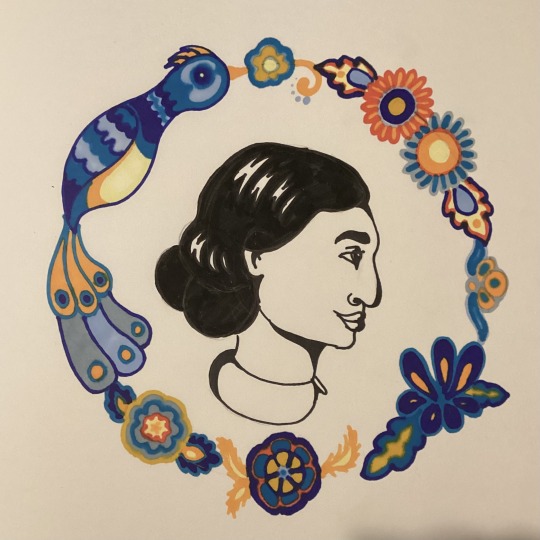
And we’ve come to Day 31: Pelaheia Lytyvnova!
Pelaheia was born in a small village (likely the town of Tereben) in modern-day Ukraine. Her family was well-off, and her mother had aristocratic origins, but Pelaheia was orphaned young, and spent her childhood at boarding schools. Her eventual husband, Petro Lytyvnova, likewise came from a well-to-do, scholarly family, and Pelaheia devoted herself to the education of their ten children, boys and girls alike.
With her children grown, however, Pelaheia seems to have found herself a bit adrift - but not for long. She threw herself into the cause of women’s education, and in 1872 received a teaching certificate. She opened a school in Kyiv, where poor children could receive the same education as the rich, but was unable to secure long-term funding or support. Undaunted, she continued her activism, supporting women’s rights and assisting the poor.
Pelaheia was also fascinated by Ukrainian folk art, particularly embroidery, and what began as a collection became a scholarly pursuit. She catalogued traditional techniques and patterns, and published a two-volume collection, preserving the artwork for posterity and sharing it with the world; her work eventually saw her elected to multiple scientific societies, a rare achievement for a nineteenth-century woman. She also recorded folktales, and eventually moved to the tiny village of Zemlyanka, where she published articles in academic journals and learned to make some of the art herself; in her last years, still active, she developed a passion for weaving.
One of the best-known forms of folk art in Ukraine is Petrykivka painting, with its distinctive flowery and colorful designs, here depicted in shades of blue and yellow; folk art has increasingly become a symbol of Ukrainian unity and resistance.
#pelaheia lytyvnova#history#ukrainian history#awesome ladies of history#october 2022#comes to a close#my art
21 notes
·
View notes
Text
You guys need to check out Lyubov Panchenko asap.
So, the algorithm threw a really good artist, Lyubov Panchenko, in my direction today. Some of you guys probably already know of her, but for those of you who don't, she was a Ukrainian artist who fought political oppression and censorship through her art. I discovered her through this painting-
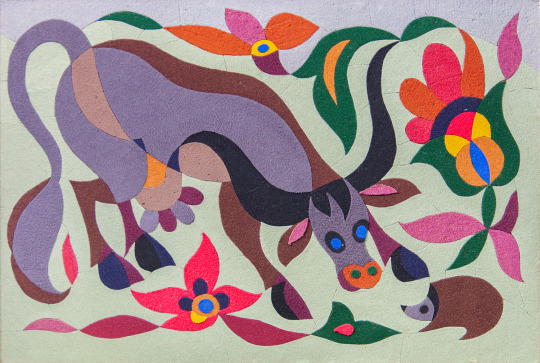
It's called "An Unexpected Meeting", and it's made entirely from fabric scraps. I absolutely adore the colours she used in her paintings, and the creativity she had.
To fight Russian oppression and preserve Ukrainian culture, Lyubov kept alive Ukrainian traditions such as painting Easter eggs, making national costumes for choirs, and incorporating Ukrainian symbols, folktales and legends, into her paintings.
Here's some of the paintings that I think are really neat:




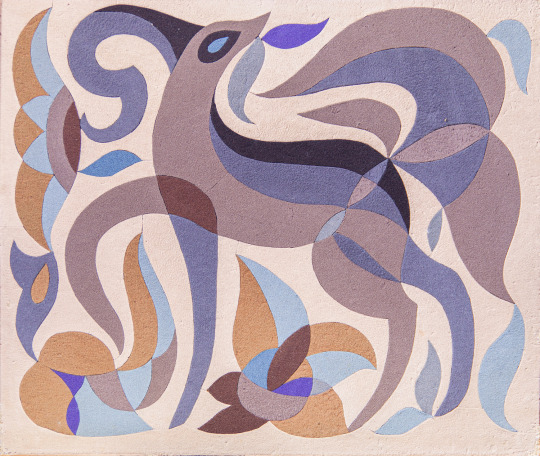

The only thing holding me back rn is the tumblr image limit.
Sadly, the reason I'm typing "was" instead of "is" everywhere, is because, at age 84, Lyubov Panchenko starved to death in the 2022 Russian invasion of Ukraine.
A more poetic soul would have better words to say about this tragedy, but all I can say is that, I hope Ukraine comes out of this mess, and that Lyubov's tireless preservation of Ukrainian culture does not go in vain.
18 notes
·
View notes
Text
Russia/Ukraine 🇷🇺/🇺🇦 Viy Вий (1967) dir. Yershov & Kropachyov/
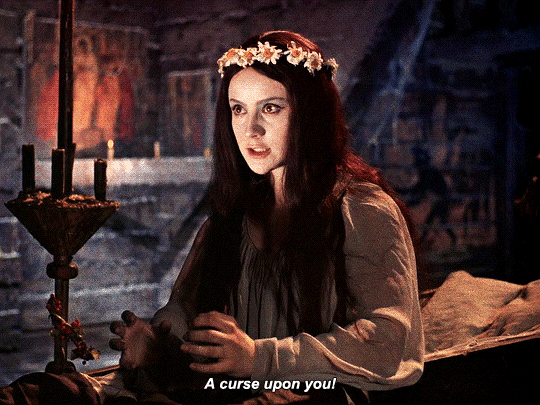
story by Nikolai Vasilyevich Gogol (1835). Who was a Russian novelist, short story writer and playwright of Ukrainian origin.
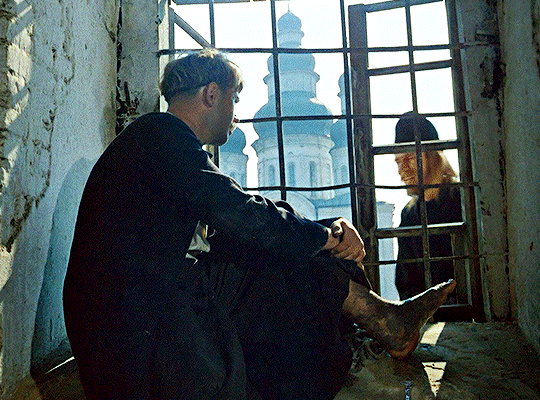
☦️The protagonist, a young man, has been under the authorities from the beginning. It is especially represented by the church and the older Cossack men. Unruly students are warned of the path of sin, but they hardly care. The witch lets three of them into her house, but separates them. At night, this mathriarc, Baba Yaga harnesses one of them for a flight (which is a common Sabbath belief, not always flown with a broom or cow).

The figure of the Rusalka is also mixed with the Slavic witch, water spirit a nymph. After her death she becomes another folk believe, a Klikushi who often disrupted village life, especially at religious ceremonials.🪆
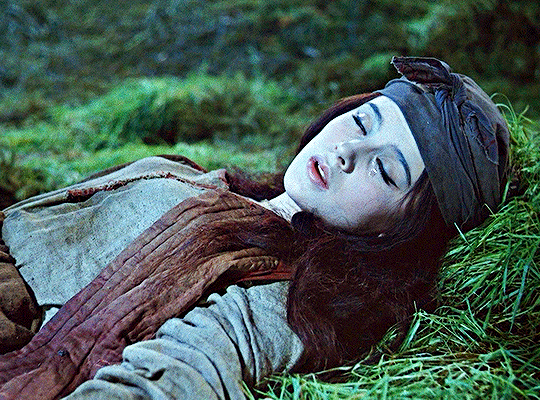
🛐We return to the beginning of the film. People’s own bad behavior finds the “guilty” often from outside of the self, rather than taking responsibility for it. The young man must atone for his sins. The nocturnal church scenes are reminiscent of humorous folk tales where one has had to go to church at night to pray, to be saved from the devils.
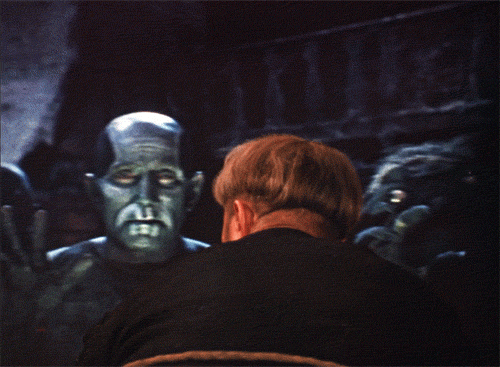
The film is difficult to interpret because it draws from so many cultural sources. In its 🇮🇹 version, Bava’s “Black Sunday”, is easier to see through the “return of the repressed" theme. After Mario Bava developed a four-page outline faithfully based on Gogol's story, several other screenwriters, both credited and uncredited, worked on the script.
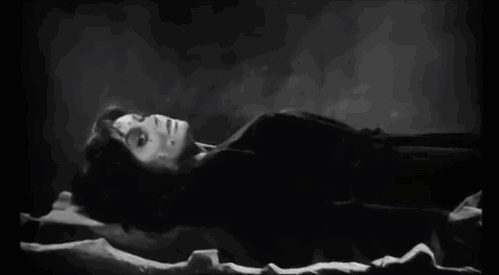
Repressed desires or feared temptations here? The obvious themes are of course regret and revenge.
The witch who attempts to ride her would-be husband is echoed in Ukrainian but also a Russian folktale. Gogol has stated that the Viy means “Little Russians” and the viy has come to be considered a product of Gogol's own imagination rather than Russian or Ukrainian folklore. He was a master of comedy, so I would not take the question of origin too seriously.
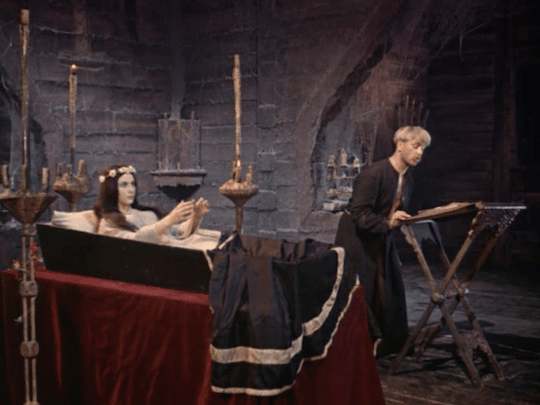
Great book & film⭐️⭐️⭐️⭐️⭐️

🌔 Suitable listening: Dvořák - the "Song to the Moon" Anna Netrebko version🙂
youtube
#viy#nikolai gogol#Вий#baba yaga#klikushi#russia#ukraine#anna netrebko#rusalka#moon#witchcraft#witch#witches#cinema#movies#film#folklore#horror film#horror#folk horror#mario bava#black sunday#Youtube
16 notes
·
View notes